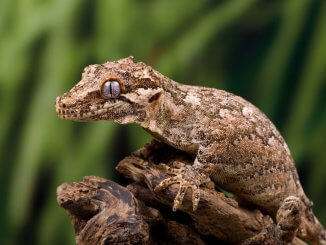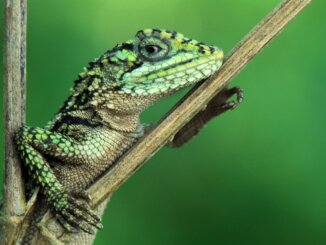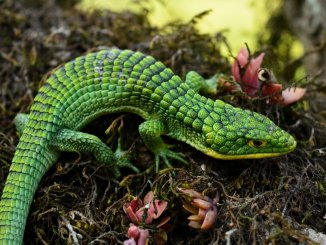The Mali uromastyx is a large lizard with a camouflage pattern of black, white, and yellow spots. Originating in the arid scrublands of Mali, Africa, this lizard is used to hot, dry conditions.
Mali uromastyx are easy to care for, provided they have a large tank with a stable temperature.
Mali Uromastyx Overview
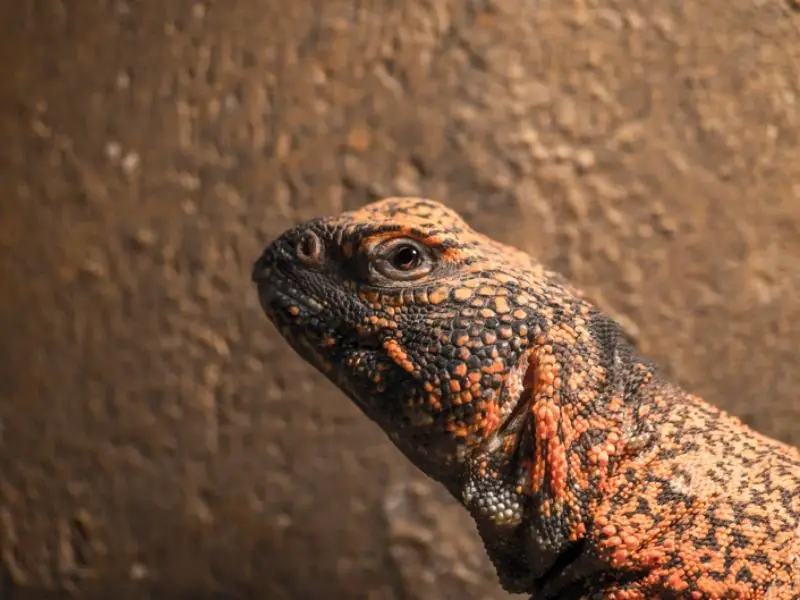
| Common name | Mali uromastyx |
| Scientific name | Uromastyx maliensis |
| Natural habitat | Hot, dry, arid desert areas in Mali, Africa |
| Adult size | 10 to 16 inches |
| Average lifespan | 12 to 20 years |
| Diet | Herbivorous |
| Housing | Large tank with controlled hot temperature |
| Experience level | Beginner to intermediate |
Origin
The Mali uromastyx (Uromastyx maliensis) is commonly found in the arid desert areas of Mali, Africa. This lizard thrives in hot, dry captive conditions that mimic its native origins.
This species is not only popular as a pet. In its native country, this lizard is considered a delicacy and is eaten by the locals.
Appearance and Behavior
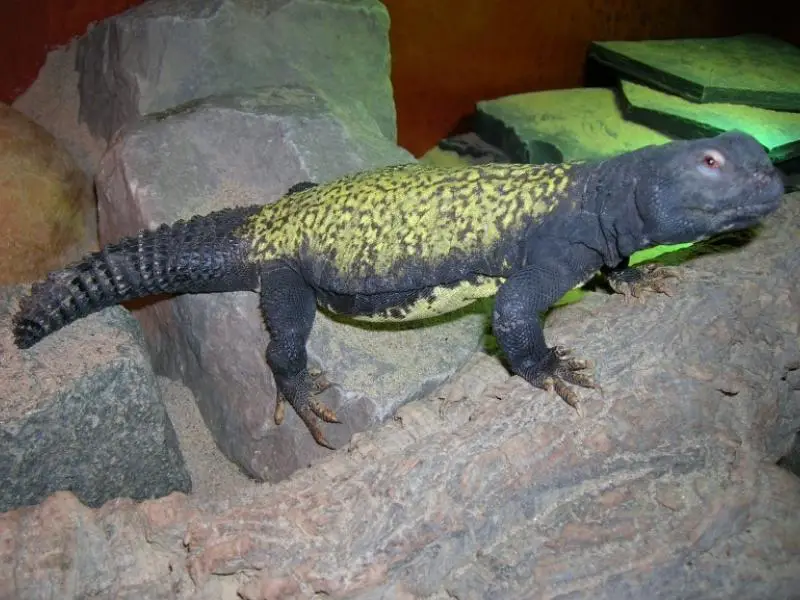
The Mali uromastyx is a medium-sized lizard whose body color changes as it matures. The young lizard has a camouflaged appearance with charcoal spots against a light gray background.
As the lizard grows to adulthood, its colors change — the male turning black with a yellow pattern and the female developing a patterned mix of light and dark brown. The male sometimes has a plain black head, tail, and legs, with a yellow-patterned torso.
With a rounded head and pointy snout, the Mali uromastyx has an unusual, spiky, highly flexible tail that looks like spinal vertebrae.
Size and Lifespan
A fully grown male Mali uromastyx reaches a length of up to 16 inches and weighs up to 15 ounces, while the female measures from 10 to 14 inches long and weighs up to 12 ounces.
Mali uromastyx have a lifespan of up to 20 years in captivity.
Temperament
The male Mali uromastyx is territorial and aggressive towards other males. House this lizard in a single enclosure to avoid aggression between species.
When housing a male and female Mali uromastyx together, the male may constantly try to mate with the female and the female may become irritable. Only house a male and female together if you want them to breed.
A young Mali uromastyx that grows up in captivity learns to know and trust its keeper, has a placid temperament, and can be handled gently. This lizard seldom bites and will warn you off by swishing its tail and hissing when it feels threatened or unhappy. If it does bite, the bites are small nips that don’t hurt.
Housing Mali Uromastyx
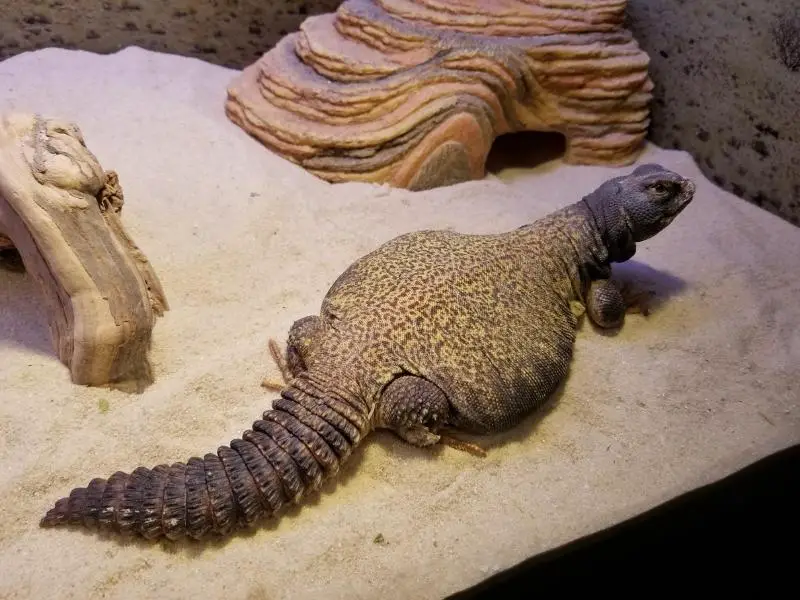
The Mali uromastyx is used to rocky and sandy areas in Mali’s hot, arid, desert territories. In captivity, house a Mali uromastyx in a terrarium with lots of sandy and rocky hiding places to replicate the species’ native conditions.
Enclosure Size
Young Mali uromastyx need a 30-gallon terrarium, and a fully grown specimen needs at least a 50-gallon terrarium (36 x 18 x 18 inches). The more space this species has, the calmer it will be. If a Mali uromastyx feels cramped in a tank that’s too small, it may scratch on the glass constantly, known as glass surfing, and become highly distressed.
Lighting
UVB lighting is necessary for the Mali uromastyx’s tank to enable the specimen to absorb calcium. Without UVB lighting this lizard is likely to develop metabolic bone disease (MBD), which is associated with calcium deficiency.
The UVB light should be placed under the lid of the tank and left on for 12 hours per day. Turn the light off at night to allow the lizard to sleep peacefully.
Temperature and Humidity
In its native habitat, the Mali uromastyx enjoys hot, dry conditions. Provide similar conditions in its tank, with a basking surface temperature of 120°F. Use a heating pad or a heat lamp to create a warm area on one side of the tank.
Ensure that there’s a cooler side in the tank with a temperature between 80 and 85°F. At night the Mali uromastyx prefers a lower temperature of 70°F.
Mali uromastyx thrive with humidity between 10% and 25%. Humidity in the lizard’s enclosure should be monitored with a hygrometer to ensure that the humidity doesn’t drop too low and induce excessive shedding of the lizard.
If excessive shedding occurs, rehydrate the tank by placing moist moss in the tank. Don’t spray the Mali uromastyx directly with water because the water will make the lizard’s skin wrinkle.
Substrate and Decoration
This lizard needs a sandy substrate in the tank that provides opportunities for digging, which the lizard does to control its body temperature. Mix sand with soil in a 1:1 ratio to allow the lizard to burrow easily.
In the wild, the Mali uromastyx enjoys basking in the sun on hot rocks. Place some rocks in the tank to give this lizard comfortable spots for basking and places to hide. Don’t include small stones that can be swallowed because this can cause severe digestive problems.
Fake plants provide shade for the Mali uromastyx, while a grape wood or Mopani branch offers opportunities for climbing. Include some crumpled pieces of paper towel or newspaper as comfortable bedding.
Avoid overcrowding the tank with plants and accessories.
Cleaning
Follow this cleaning schedule to keep your Mali uromastyx’s tank clean and sanitary:
Place the Mali uromastyx in a clean, empty temporary tank while cleaning the main tank. If you don’t have a spare tank, use a clean cardboard box.
- Weekly — Remove all debris and feces
- Monthly — Replace the substrate
- Every three months — Remove everything from the tank and wash the tank with warm water and mild soap. Use lemon juice or vinegar to remove stains. Rinse the plants and rocks with warm water. Rinse the tank well with warm water to remove all traces of soap before replacing the tank’s contents and the lizard
Mali Uromastyx Care
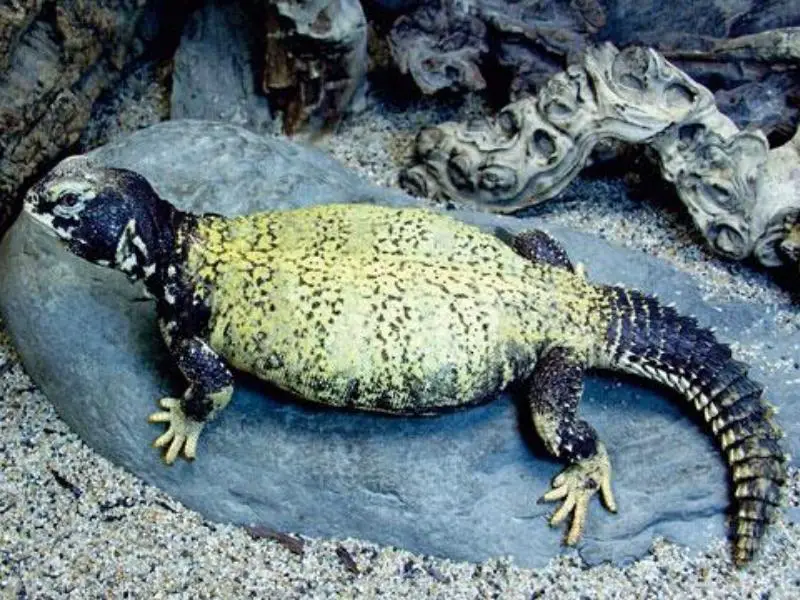
The Mali uromastyx is easy to care for with the correct equipment. A clean tank with a suitable substrate, warm temperature, and low humidity will keep this lizard comfortable.
Food and Water
In the wild, the Mali uromastyx is mostly herbivorous, although it occasionally eats insects and worms. In captivity, a vegetable-based diet keeps the adult and juvenile lizards healthy.
Offer the baby Mali uromastyx small crickets and worms, and avoid feeding baby lizard vertebrates because the young reptiles cannot digest the bones. As the Mali uromastyx grows, it needs less meat in its diet, and eventually becomes totally herbivorous.
Offer the lizard commercial reptile foods or feed it fresh vegetables like lettuce and other green leafy veggies, peas, green beans, small pieces of carrot, squash, and turnip greens. Add some birdseed for variety. Place the food in a small bowl in a corner of the tank.
Feed the young Mali uromastyx daily, and reduce feeding to four or five times a week for adult specimens.
Offering water in a bowl isn’t necessary because the Mali uromastyx gets enough hydration from the natural water content in its food.
Handling
The Mali uromastyx can be trained to tolerate and even enjoy being handled. Avoid handling the lizard for the first week after bringing it home so the lizard can get used to its new surroundings.
Build trust in a young specimen by regularly offering it food directly from your hands. Spend time sitting near the tank and occasionally put your hand in the tank to stroke your Mali uromastyx.
After socializing at a distance for a week, slip your hand under the lizard’s body and lift it gently, allowing the lizard to sit on your hand. Replace the Mali uromastyx back in its tank after a few seconds. Repeat this process frequently, gradually extending the time that you hold the lizard. Your Mali uromastyx will soon get used to being gently held and caressed.
When holding your Mali uromastyx, avoid sudden movements and loud noises. Teach young children how to handle the Mali uromastyx correctly without hurting or startling the lizard.
Common Health Issues
Numerous common health issues can affect the Mali uromastyx:
- Parasites — Sudden weight loss, runny stools, and blood in the stools are signs of a parasitic infection and need urgent treatment by a vet
- Dehydration — Sunken eyes and loss of appetite are the main signs of dehydration, which can be caused by stress from being transported, or by excessively high tank temperature. Adjust the temperature in the tank and rehydrate the Mali uromastyx by placing a bowl of water in the tank. Spray leafy foods lightly with water so that the lizard can lick the water droplets
- Metabolic bone disease (MBD) — Lethargy and shaking are the first signs of MBD, a disease caused by a lack of calcium and vitamin D3. Ensure that the UVB light has an output of at least 10%–14% to encourage the production of vitamin D3
- Tail rot — Black patches on the lizard’s tail are a sign of tail rot, which is caused by excessive humidity. Keep the humidity level in the tank under 30% to prevent tail rot. Treat tail rot with antibiotics and by cleaning the tail three times a day with betadine diluted with warm water. Use 1 part betadine to 10 parts water, and dry the tail afterward by patting it gently with a clean towel
Burns
Because the Mali uromastyx loves heat, this reptile instinctively seeks out the warmest spot in the tank, which is usually close to the heat lamp. Cover the bulb of the heat lamp with a light guard to protect your lizard from burns caused by touching the bulb.
If your Mali uromastyx gets burned, apply burn ointment to the burn twice a day until the burn has healed. If the burn becomes inflamed, apply antibiotic ointment to treat the infection.
Breeding
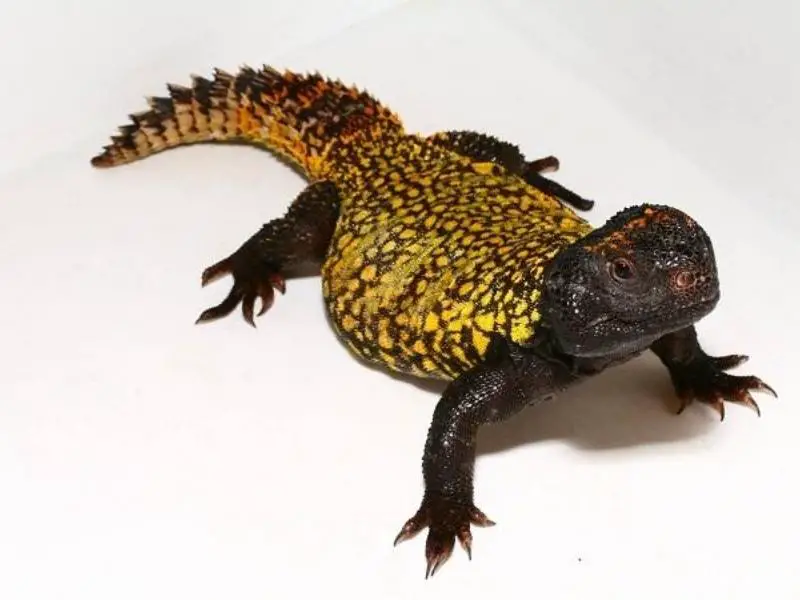
Identify the sex of a Mali uromastyx by lifting the tail. The male has a bulge on either side of the tail base, with a flat area between the two bulges. The female doesn’t have bulges and its body is completely flat under the tail.
Breeding Mali uromastyx in captivity is complicated and is usually only successful when monitored by professional breeders. Breeding takes place in captivity after natural winter conditions are replicated. Follow these steps to encourage breeding:
Creating the Breeding Environment
Take a small box and cut a hole in the top. Add a substrate made of half fine sand and half peat moss, moistened with water. Place the box in a reptile tank, on the cooler side. Position the tank in a dark area.
Reducing Daylight Hours and Temperature
Place a male and female Mali uromastyx inside the box in the tank and begin replicating winter conditions by gradually lowering the temperature and reducing the number of hours of light per day. Reduce light by two hours a week until you reach six hours of light a day.
Gradually lower the temperature over a period of three to four weeks, until the temperature is 85°F during the day and 60°F at night.
Feeding Schedule
Feed the lizards moist vegetable leaves every second day during the weeks of lowering the temperature and reducing daylight hours. Stop feeding when you are down to six hours of light per day.
Brumation
Brumation is the period during which cold-blooded creatures hibernate. Allow 60 days of brumation, then gradually start increasing daylight hours by one hour per week and raise the temperature slowly, until normal conditions have been restored.
Mating and Gestation
Mating takes place as soon as full daylight hours and regular temperature have been restored. Four weeks after mating, the female lays between 10 and 20 eggs.
Transfer the Eggs to an Incubator
Fill a plastic container (11 x 7 x 4 inches) two-thirds full with a dampened mixture of vermiculite, activated charcoal, and perlite. Place the eggs in the bedding mixture, covering them until only the tops of the eggs are visible. Cover the container with a lid.
Incubate the eggs at 92°F, removing the lid once a week for a few minutes to allow fresh air to circulate.
The eggs hatch after 8 to 10 weeks. Place the babies in a tank with a moist paper towel substrate. Leave a small, shallow dish of fresh water in the tank for the first two months, and feed the lizards twice a day.
Choosing and Buying a Mali Uromastyx
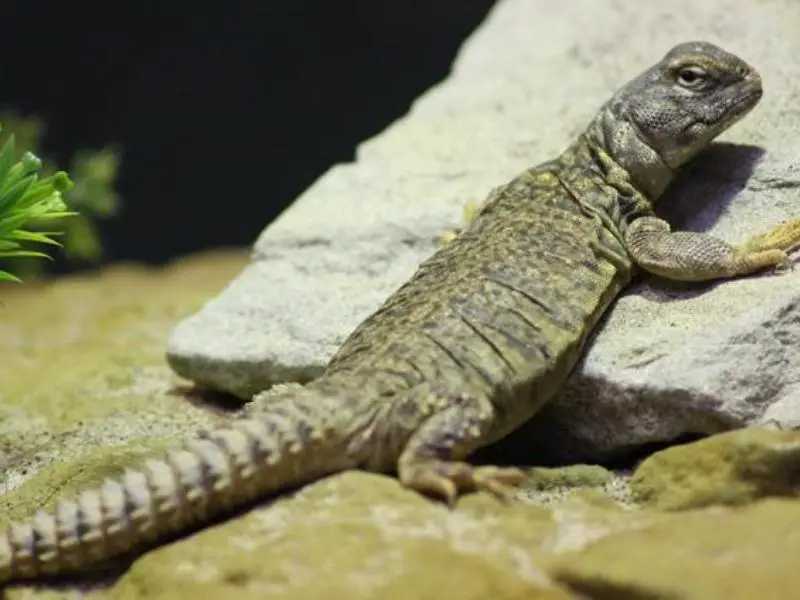
Buy a Mali uromastyx from a reputable pet store or breeder to ensure that the reptile doesn’t have health problems. Buying a baby bred in captivity offers a better chance of getting a healthy Mali uromastyx.
Fully grown Mali uromastyx that are for sale have often been imported illegally and have parasites and diseases. These specimens don’t do well in captivity.
Examine the eyes of the Mali uromastyx. Avoid a specimen with sunken eyes, which are often a sign of disease or dehydration. Choose a brightly colored Mali uromastyx with no solid black patches on its tail (a possible indication of tail rot).
Expect to pay between $100 and $200 for a healthy Mali uromastyx hatchling.

